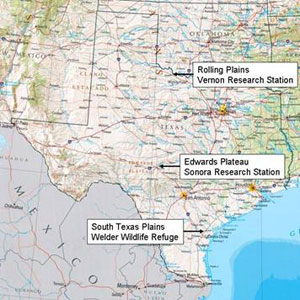Funding NRCS CIGS
Project Duration October 2005 – September 2009
Research collaborators
Urs Kreuter (PI), Richard Conner, Bill Rogers, Ecosystem Science and Management, Texas A&M University, College Station, TX
Butch Taylor, Texas AgriLife Research, Sonora TX
Richard Teague, Texas AgriLife Research, Vernon TX
Project Objectives
- Quantify the ecological impact of fire when air temperature exceeds 95 degrees Fahrenheit and/or when relative humidity is less than 20%, and collate and analyze existing and new data regarding the effects of summer fires on rangeland plant communities.
- Evaluate the economic effectiveness of using prescribed summer burns as a rangeland restoration tool, compared to other rangeland restoration strategies.
- Evaluate landowner interest in and concerns about using prescribed summer fires, as well as their interest in using EQIP funds to implement summer burns.
- Through modeling, provide an objective means for examining the implications of including prescribed summer fire in alternative livestock and wildlife production systems over an extended range of management options, physical conditions and weather sequences.
- Provide scientifically rigorous research results to support revisions of the technical standards and specifications and potential policy changes by the NRCS with respect to the use of prescribed summer burning.
 This project was conducted in the Rolling Plains, Edwards Plateau and gulf coast areas of Texas. Field research was conducted at three sites across Texas to compare the ecological effects of summer fires with other treatments for restoring Southern Plains rangelands back to historically dominant plant community structures. These ecological data together with secondary production and input price data will be used to estimate the economic effectiveness of using summer fire compared to other rangeland restoration treatments. The social acceptability to landowners of using prescribed summer fires relative to other restoration practices will be assessed. A modeling component will be used to predict the overall value of implementing prescribed summer burns as a rangeland restoration tool for alternative rangeland-based production systems. Policy recommendations will be provided based on the findings of the study.
This project was conducted in the Rolling Plains, Edwards Plateau and gulf coast areas of Texas. Field research was conducted at three sites across Texas to compare the ecological effects of summer fires with other treatments for restoring Southern Plains rangelands back to historically dominant plant community structures. These ecological data together with secondary production and input price data will be used to estimate the economic effectiveness of using summer fire compared to other rangeland restoration treatments. The social acceptability to landowners of using prescribed summer fires relative to other restoration practices will be assessed. A modeling component will be used to predict the overall value of implementing prescribed summer burns as a rangeland restoration tool for alternative rangeland-based production systems. Policy recommendations will be provided based on the findings of the study.
There are 3 students working on their graduate degrees to complete these objectives and results will be posted when these studies have been completed.